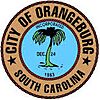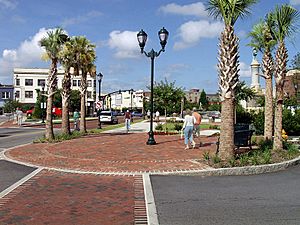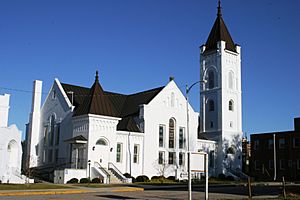Orangeburg, South Carolina facts for kids
Quick facts for kids
Orangeburg, South Carolina
|
||
|---|---|---|
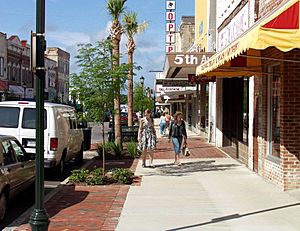
Central Business District of Orangeburg
|
||
|
||
| Nickname(s):
The Burg
|
||
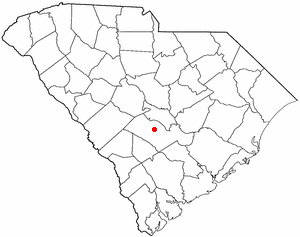
Location in Orangeburg County, South Carolina
|
||
| Country | ||
| State | ||
| County | Orangeburg | |
| Area | ||
| • Total | 9.02 sq mi (23.36 km2) | |
| • Land | 9.01 sq mi (23.34 km2) | |
| • Water | 0.01 sq mi (0.02 km2) | |
| Elevation | 243 ft (74 m) | |
| Population
(2020)
|
||
| • Total | 13,240 | |
| • Density | 1,469.15/sq mi (567.23/km2) | |
| Time zone | UTC−5 (EST) | |
| • Summer (DST) | UTC−4 (EDT) | |
| ZIP codes |
29115-29118
|
|
| Area code(s) | 803, 839 | |
| FIPS code | 45-53080 | |
| GNIS feature ID | 1249990 | |
| Website | www.orangeburg.sc.us | |
Orangeburg, also known as The Burg, is a city in South Carolina, United States. It's the main city and county seat of Orangeburg County. In 2020, about 13,240 people lived there. The city is located 37 miles southeast of Columbia, near the North Fork of the Edisto River.
Orangeburg is home to two important historically black universities: Claflin University and South Carolina State University. These schools have played a big role in the city's history and community.
Contents
History of Orangeburg
Early Settlement in the 1700s
European settlers first came to this area in 1704. George Sterling set up a trading post for furs with Native Americans. To encourage more people to move here, the government of South Carolina created a township in 1730. They named it Orangeburg after William IV, Prince of Orange, who was related to King George II of Great Britain.
In 1735, about 200 Swiss, German, and Dutch immigrants started a community. They settled near the North Edisto River. This spot was great because of its rich soil and lots of wildlife. The river was also a key way to transport farm goods and lumber to the port of Charleston. Soon, Orangeburg became a successful colony, mostly made up of small farmers.
Orangeburg's first church was built by German Lutherans. It later became an Anglican Church. This church was destroyed during the American Revolutionary War. A new church was built, but during the American Civil War, General William Tecumseh Sherman used it as a hospital.
Changes in the 1800s
After the American Revolution, the area changed a lot. The invention of the cotton gin by Eli Whitney made it easy to grow cotton. This led to many large cotton farms, called plantations. Enslaved African Americans were forced to work on these plantations. They were brought from other areas, and soon became the majority of people in the county.
After the Civil War, enslaved people became free. They started getting an education, and two colleges were built in Orangeburg for black students. However, new laws, called Jim Crow laws, made it hard for black people to vote and treated them unfairly. In 1919, the Orangeburg Regional Medical Center opened.
Civil Rights Efforts in the 1900s
After World War II, black citizens worked hard to gain equal rights. In the 1960s, Orangeburg became a key place for the Civil Rights Movement. Students from Claflin College and South Carolina State College joined with local residents to protest.
In 1956, people tried to end segregation in public schools. White people sometimes fired or evicted activists as a response. College students supported them with protests and marches. In 1960, over 400 students were arrested during sit-ins and marches organized by the Congress of Racial Equality (CORE).
In August 1963, the Orangeburg Freedom Movement asked the city to end segregation. When talks failed, more than 1,300 people were arrested during large protests. Efforts to end segregation continued, especially after the Civil Rights Act of 1964 was passed.
On February 8, 1968, protests against a segregated bowling alley led to violence. Police opened fire on a crowd of students from South Carolina State. Three students, Samuel Hammond, Henry Smith, and Delano Middleton, were killed, and 27 others were hurt. This sad event became known as the "Orangeburg Massacre".
Orangeburg in the 2000s
In May 2000, the city started the Orangeburg County Community of Character program. This was a team effort to improve the community. In 2005, Orangeburg County won the All-America City Award. This award recognizes communities where people, government, and businesses work together to solve problems.
In 2007, Orangeburg hosted the first debate for Democratic U.S. presidential candidates. Future president Barack Obama was one of the debaters. In 2021, President Joe Biden visited Orangeburg to speak at South Carolina State University's graduation.
Orangeburg Geography and Climate
Orangeburg covers about 8.3 square miles (21.5 square kilometers) of land. Only a tiny part is water.
Orangeburg's Climate
Orangeburg has a humid subtropical climate. This means it has high temperatures and rain throughout the year. Summers are hot and humid, while winters are mild.
| Climate data for Orangeburg, South Carolina (1991–2020 normals, extremes 1953–present) | |||||||||||||
|---|---|---|---|---|---|---|---|---|---|---|---|---|---|
| Month | Jan | Feb | Mar | Apr | May | Jun | Jul | Aug | Sep | Oct | Nov | Dec | Year |
| Record high °F (°C) | 84 (29) |
86 (30) |
92 (33) |
97 (36) |
102 (39) |
105 (41) |
105 (41) |
108 (42) |
102 (39) |
99 (37) |
91 (33) |
90 (32) |
108 (42) |
| Mean daily maximum °F (°C) | 59.6 (15.3) |
63.2 (17.3) |
70.2 (21.2) |
77.8 (25.4) |
84.8 (29.3) |
90.4 (32.4) |
92.9 (33.8) |
91.7 (33.2) |
86.9 (30.5) |
78.6 (25.9) |
69.0 (20.6) |
61.7 (16.5) |
77.2 (25.1) |
| Daily mean °F (°C) | 48.1 (8.9) |
51.4 (10.8) |
57.9 (14.4) |
65.1 (18.4) |
72.7 (22.6) |
79.3 (26.3) |
82.2 (27.9) |
81.4 (27.4) |
76.2 (24.6) |
66.4 (19.1) |
56.3 (13.5) |
50.0 (10.0) |
65.6 (18.7) |
| Mean daily minimum °F (°C) | 36.6 (2.6) |
39.6 (4.2) |
45.6 (7.6) |
52.4 (11.3) |
60.5 (15.8) |
68.2 (20.1) |
71.5 (21.9) |
71.2 (21.8) |
65.6 (18.7) |
54.1 (12.3) |
43.6 (6.4) |
38.4 (3.6) |
53.9 (12.2) |
| Record low °F (°C) | 2 (−17) |
9 (−13) |
6 (−14) |
27 (−3) |
35 (2) |
47 (8) |
54 (12) |
53 (12) |
40 (4) |
27 (−3) |
18 (−8) |
6 (−14) |
2 (−17) |
| Average precipitation inches (mm) | 3.96 (101) |
3.86 (98) |
3.89 (99) |
3.29 (84) |
4.04 (103) |
5.47 (139) |
5.80 (147) |
5.29 (134) |
4.49 (114) |
3.52 (89) |
3.09 (78) |
3.78 (96) |
50.48 (1,282) |
| Average snowfall inches (cm) | 0.1 (0.25) |
0.0 (0.0) |
0.0 (0.0) |
0.0 (0.0) |
0.0 (0.0) |
0.0 (0.0) |
0.0 (0.0) |
0.0 (0.0) |
0.0 (0.0) |
0.0 (0.0) |
0.0 (0.0) |
0.0 (0.0) |
0.1 (0.25) |
| Average precipitation days (≥ 0.01 in) | 10.2 | 9.6 | 9.4 | 8.2 | 8.9 | 11.0 | 11.0 | 11.1 | 8.5 | 7.6 | 7.5 | 10.0 | 113.0 |
| Source: NOAA | |||||||||||||
Orangeburg Population and People
| Historical population | |||
|---|---|---|---|
| Census | Pop. | %± | |
| 1860 | 997 | — | |
| 1870 | 246 | −75.3% | |
| 1880 | 2,140 | 769.9% | |
| 1890 | 2,964 | 38.5% | |
| 1900 | 4,455 | 50.3% | |
| 1910 | 5,906 | 32.6% | |
| 1920 | 7,290 | 23.4% | |
| 1930 | 8,776 | 20.4% | |
| 1940 | 10,521 | 19.9% | |
| 1950 | 15,322 | 45.6% | |
| 1960 | 13,852 | −9.6% | |
| 1970 | 13,252 | −4.3% | |
| 1980 | 14,933 | 12.7% | |
| 1990 | 13,739 | −8.0% | |
| 2000 | 12,765 | −7.1% | |
| 2010 | 13,964 | 9.4% | |
| 2020 | 13,240 | −5.2% | |
| U.S. Decennial Census | |||
Orangeburg's Diverse Community (2020 Census)
| Race / Ethnicity (NH = Non-Hispanic) | Pop 2000 | Pop 2010 | Pop 2020 | % 2000 | % 2010 | 2020 |
|---|---|---|---|---|---|---|
| White alone (NH) | 3,758 | 2,891 | 2,237 | 29.44% | 20.70% | 16.90% |
| Black or African American alone (NH) | 8,577 | 10,411 | 10,119 | 67.19% | 74.56% | 76.43% |
| Native American or Alaska Native alone (NH) | 17 | 24 | 48 | 0.13% | 0.17% | 0.36% |
| Asian alone (NH) | 145 | 231 | 277 | 1.14% | 1.65% | 2.09% |
| Pacific Islander alone (NH) | 5 | 7 | 14 | 0.04% | 0.05% | 0.11% |
| Some Other Race alone (NH) | 30 | 12 | 36 | 0.24% | 0.09% | 0.27% |
| Mixed Race or Multi-Racial (NH) | 68 | 122 | 249 | 0.53% | 0.87% | 1.88% |
| Hispanic or Latino (any race) | 165 | 266 | 260 | 1.29% | 1.90% | 1.96% |
| Total | 12,765 | 13,964 | 13,240 | 100.00% | 100.00% | 100.00% |
In 2020, Orangeburg had 13,240 people living in 4,455 households. About half of these households were families.
Orangeburg's Population in 2010
In 2010, Orangeburg had 13,964 people. Most of the population, about 75%, was African American. About 19% were White, and smaller groups included Asian, Native American, and Pacific Islander people. About 1.9% of the population was Hispanic or Latino.
The city had 4,421 households. About 18.9% of these had children under 18. The average household had 2.23 people. The median age in the city was 28 years old.
Education in Orangeburg
Colleges and Universities
- Claflin University: Founded in 1869, it's the oldest historically black university in South Carolina. In 2014, it was ranked as a top liberal arts college.
- South Carolina State University: This is a public, four-year historically black university. It was founded in Orangeburg in 1896.
- Orangeburg–Calhoun Technical College: This college offers associate degrees. It is part of the American Association of Community Colleges.
Public Schools
Orangeburg has several public school districts:
- Orangeburg Consolidated School District Three
- Consolidated School District Four
- Orangeburg Consolidated School District Five
- Orangeburg-Wilkinson Senior High School
Charter Schools
- OCSD5 High School for Health Professions
- Felton Laboratory Charter School
Private Schools
- Orangeburg Preparatory Schools, Inc.
- Orangeburg Christian Academy
Public Library
Orangeburg has a public library. It is a branch of the Orangeburg County Library system.
Media in Orangeburg
The Times and Democrat is the daily newspaper for the Orangeburg area.
Transportation in Orangeburg
Travel Hubs
- Orangeburg Municipal Airport: For air travel.
- Greyhound: For bus travel.
- Southeastern Stages: Another bus service.
Major Roads
Orangeburg is connected by several U.S. Routes and South Carolina Highways:
- U.S. Route 301
- U.S. Route 601
- U.S. Route 21
- U.S. Route 178
- South Carolina Highway 4
- South Carolina Highway 33
- Interstate 26 (via Exits 145, 149 and 154)
Fun Things to Do in Orangeburg
Edisto Memorial Gardens
The Edisto Memorial Gardens is famous for its beautiful roses. It features award-winning roses from the All-American Rose Selections. You can see about 4,000 rose plants of at least 75 different types. The garden started in the 1920s with azaleas. A playground was added in 1922, and the first rose garden was planted in 1951. Today, it has over 50 beds of roses, covering more than 150 acres.
IP Stanback Museum & Planetarium
The IP Stanback Museum & Planetarium is located at South Carolina State University. It's named after Israel Pinkney Stanback, the first African-American chairman of the university's board. The museum has one of the largest exhibition areas in the state. Its planetarium has a forty-foot dome and can seat 82 people. It's a great place to learn about art and space!
Festivals and Events
The Orangeburg Festival of Roses started in 1972. It was created to help develop Orangeburg and improve life for its residents. The festival includes fun events like a river race, a bass fishing tournament, a Princess of Roses pageant, and various sports tournaments.
In winter, Orangeburg hosts the Grand American Coon Hunt. This event takes place every January and is the largest field trial for coon dogs in the United States. It's also a qualifying event for the World Coon Hunt.
Historic Landmarks
Many important buildings and areas in Orangeburg are listed on the National Register of Historic Places. These include:
- Alan Mack Site (38OR67)
- All-Star Triangle Bowl
- Amelia Street Historic District
- Claflin College Historic District
- Dixie Library Building
- Donald Bruce House
- Dukes Gymnasium
- East Russell Street Area Historic District
- Ellis Avenue Historic District
- Enterprise Cotton Mills Building
- F.H.W. Briggman House
- Great Branch Teacherage
- Hodge Hall
- Hotel Eutaw
- Lowman Hall, South Carolina State College
- Maj. John Hammond Fordham House
- Mt. Pisgah Baptist Church
- Orangeburg City Cemetery
- Orangeburg County Fair Main Exhibit Building
- Orangeburg County Jail
- Orangeburg Downtown Historic District
- South Carolina State College Historic District
- William P. Stroman House
- Tingley Memorial Hall, Claflin College
- Treadwell Street Historic District
- Trinity Methodist Episcopal Church
- White House United Methodist Church
- Whitman Street Area Historic District
- Williams Chapel A.M.E. Church
Famous People from Orangeburg
Many notable people have connections to Orangeburg:
- Donnie Abraham: A football player for the Tampa Bay Buccaneers.
- Alex Barron: An NFL football player drafted by the St. Louis Rams.
- Shelton Benjamin: A professional wrestler.
- Gloria Blackwell: An educator and civil rights activist.
- Jim Clyburn: A congressman and alumnus of South Carolina State University.
- Choo-Choo Coleman: A former baseball catcher for the New York Mets.
- Monique Coleman: An actress and singer, known from High School Musical.
- Angell Conwell: An actress.
- Bob Corker: A former U.S. senator from Tennessee.
- Don Covay: A musician.
- Xzavion Curry: A Major League Baseball player.
- Woodrow Dantzler: A college football player for Clemson University.
- Manish Dayal: An actor.
- Ralph B. Everett: President and CEO of the Joint Center for Political and Economic Studies.
- Abby Fisher: One of the first African-American cookbook authors.
- Terry Guess: An NFL wide receiver.
- Michael Hackett: A basketball player.
- Jaime Harrison: Chairman of the Democratic National Committee.
- Deveron Harper: An NFL football player.
- Dwayne Harper: A professional football cornerback.
- Nikki Haley: Former Governor of South Carolina.
- Israel Hicks: A stage director.
- Corinne Stocker Horton: An elocutionist and journalist.
- Brad Hutto: A state senator in South Carolina.
- Tim Jennings: An NFL football player for the Indianapolis Colts.
- Brice Johnson: A basketball star who played for the University of North Carolina at Chapel Hill.
- Maurice Kelly: An NFL and CFL player.
- Mikki Moore: A professional basketball player.
- Mike O'Cain: A college football coach.
- Benjamin F. Payton: Former president of Tuskegee University.
- Walter Merritt Riggs: An engineering professor and former president of Clemson University.
- Curtis C. Robinson: A former U.S. Army Air Force officer and Tuskegee Airmen pilot.
- Eugene Robinson: A columnist for The Washington Post.
- Rusty Russell: A football player.
- John Jarvis Seabrook: A theologian and pastor.
- Bakari Sellers: A politician and CNN commentator.
- Mike Sharperson: A Major League Baseball player for the Los Angeles Dodgers.
- Dick Sheridan: A Hall of Fame college football coach.
- Shawnee Smith: An actress known for her roles in the Saw movies.
- Steve Sonic: A musician.
- Bill Spiers: A Major League Baseball player.
- Archie Spigner: A New York City Council member.
- Cecil Williams: A photographer, civil rights activist, and author.
- Johnny Williams: A jazz musician with the Count Basie Orchestra.
- Karen J. Williams: A chief judge for the United States Court of Appeals for the Fourth Circuit.
- Herm Winningham: A Major League Baseball player and World Series champion.
Images for kids
-
A controversial Confederate flag in Orangeburg owned by the Sons of Confederate Veterans.
See also
 In Spanish: Orangeburg (Carolina del Sur) para niños
In Spanish: Orangeburg (Carolina del Sur) para niños


